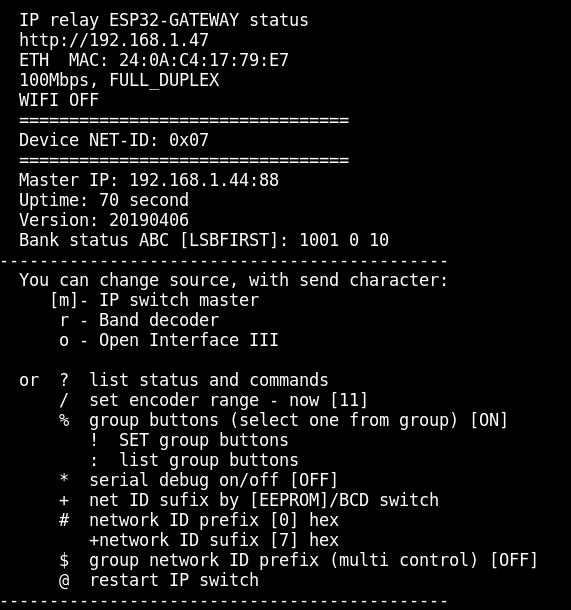IP Switch with ESP32-GATEWAY
This revision is from 2019/04/06 18:39. You can Restore it.
Designed for mounting to DIN rail.
Board serve as relay driver depenancy to used open collector/emmiter output chip. This kit worked with ESP32-GATEWAY Ethernet/WiFi module from OLIMEX. Below step by step assembled manual for 16 outputs (two boards), may be expandable.


Hardware
DC power jack

- ⚠ 5 volt DC only - higher voltage damage both electronics!
- Size 2,1/5,5mm diameter to connect input power 5V DC (center positive)
- Consumption below 500mA
P3 output header

| pin-1 | in | DC power supply +5V |
| pin-2 | in | DC power supply +5V |
| pin-3 | in | GND |
| pin-4 | in | GND |
| pin-5 | out | output 1 |
| pin-6 | out | output 2 |
| pin-7 | out | output 3 |
| pin-8 | out | output 4 |
| pin-9 | out | output 5 |
| pin-10 | out | output 6 |
| pin-11 | out | output 7 |
| pin-12 | out | output 8 |
| pin-13 | in | Vin, if use UDN driver |
| pin-14 | in | Vin, if use UDN driver |
How to assembly
Top side PCB
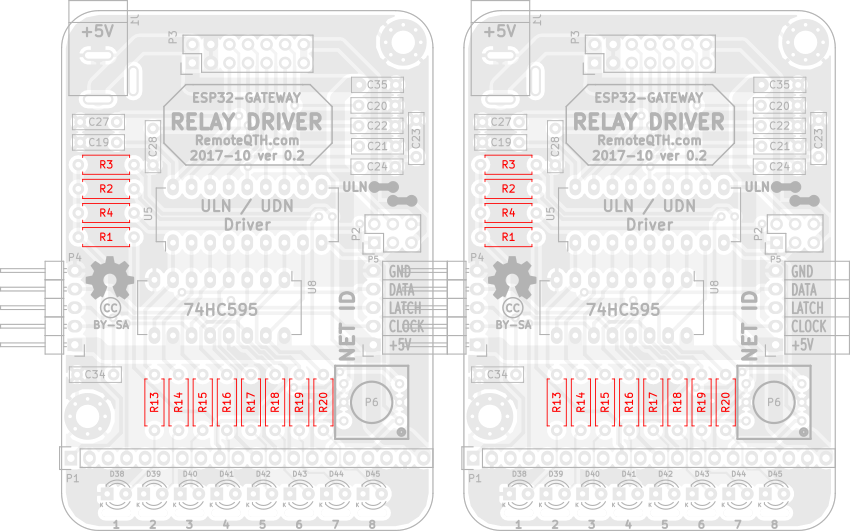
❏ Solder 2x12 1k rezistors R1-R14
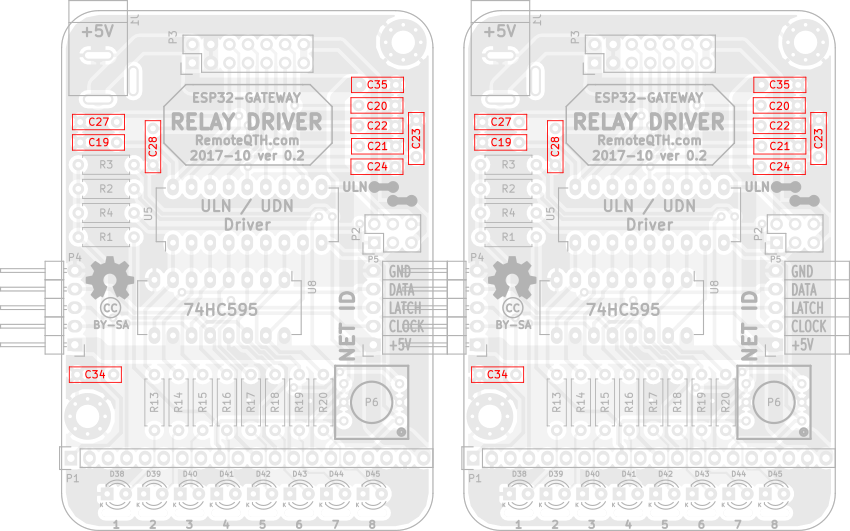
❏ 2x10 100n capacitors C19-C35
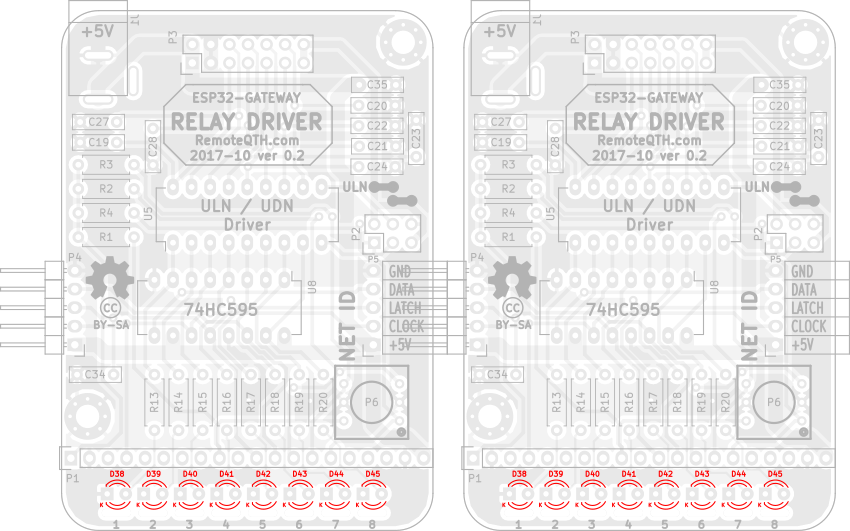
❏ 2x8 LED diodes D38-D45
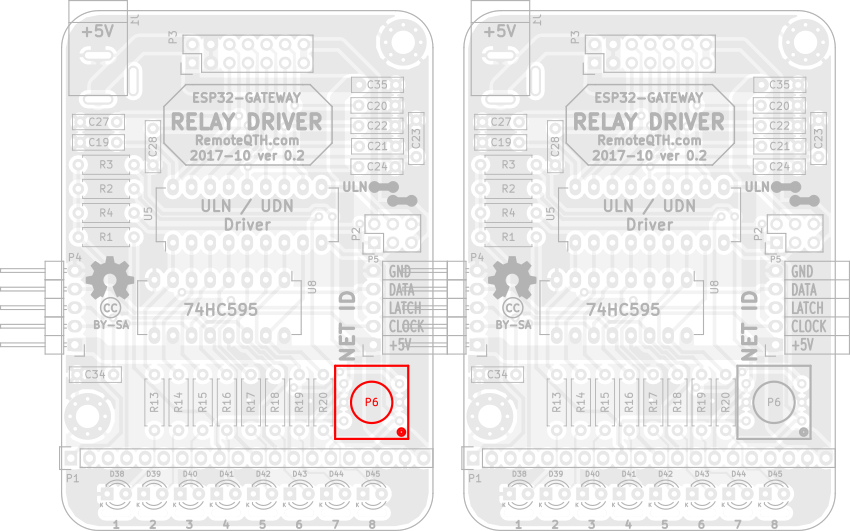
❏ One BCD ID switch P6 on LEFT board

❏ One female pin header P5 on LEFT board
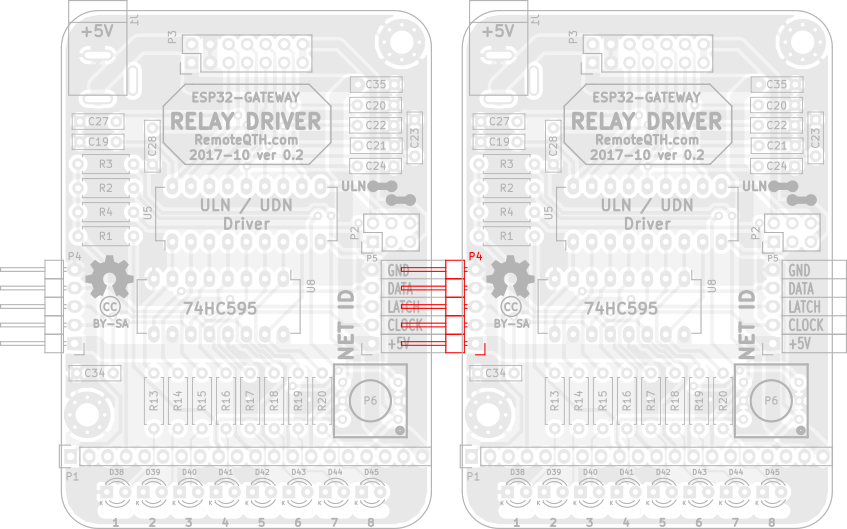
❏ One male pin header P4 on RIGHT board
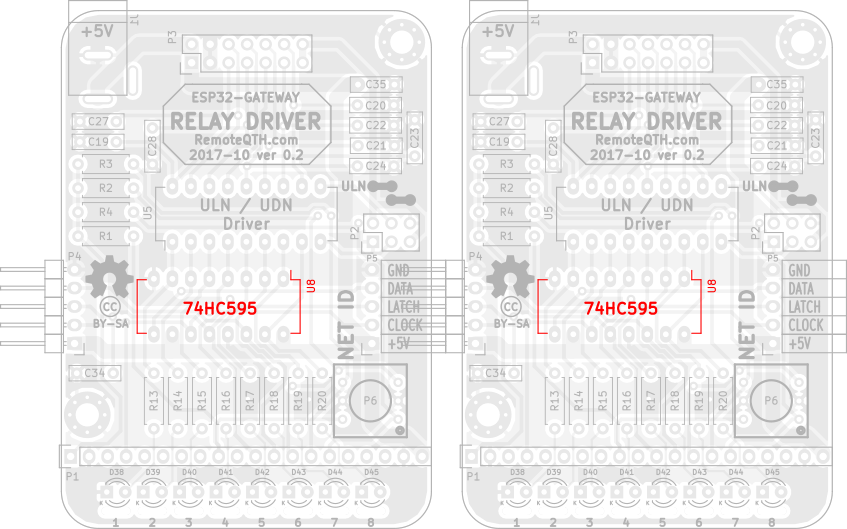
❏ 2x 74HC595 IO U8

❏ 2x DIP socket for U5
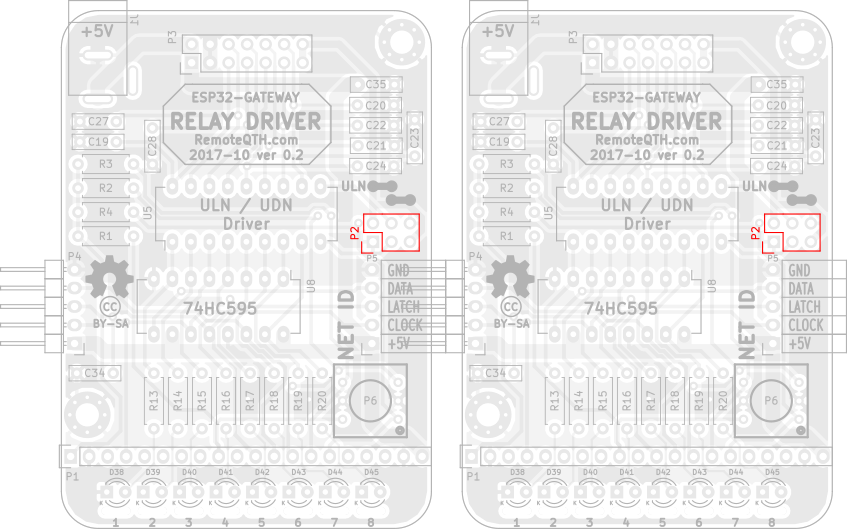
❏ 2x male 2x3 pin header P2
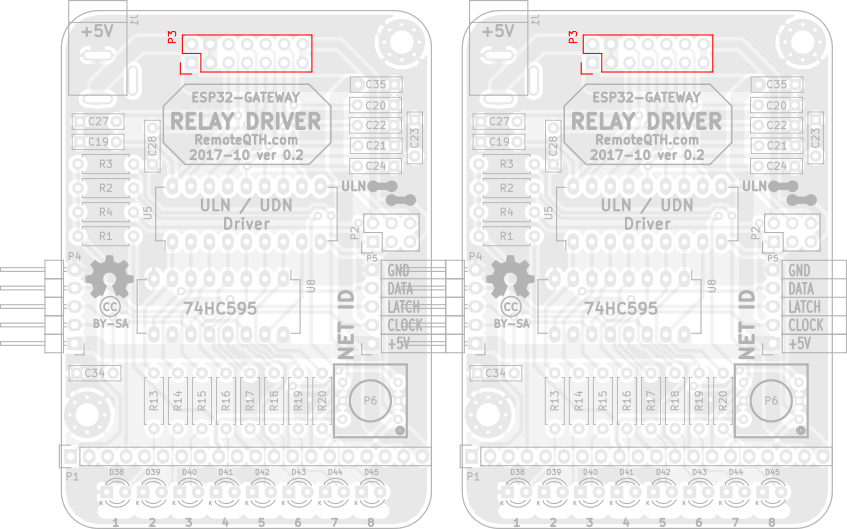
❏ 2x male 2x7 pin header P3
Bottom side PCB
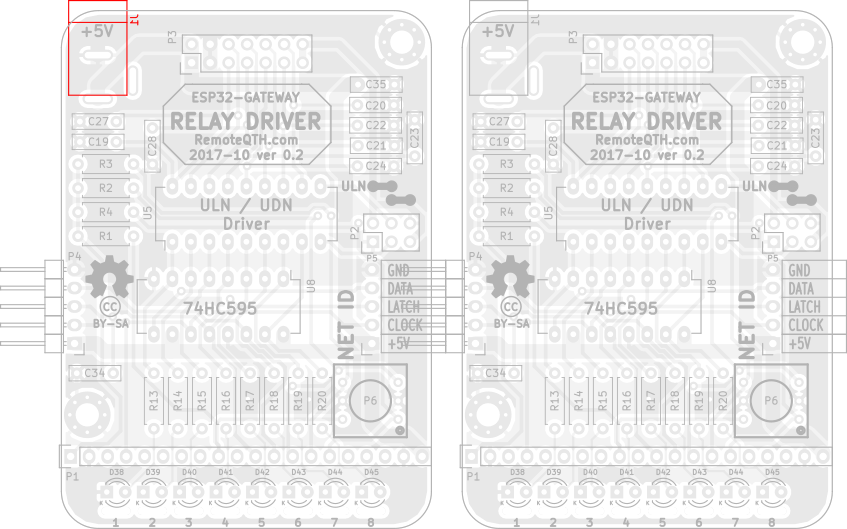
❏ One DC jack J1 on LEFT board
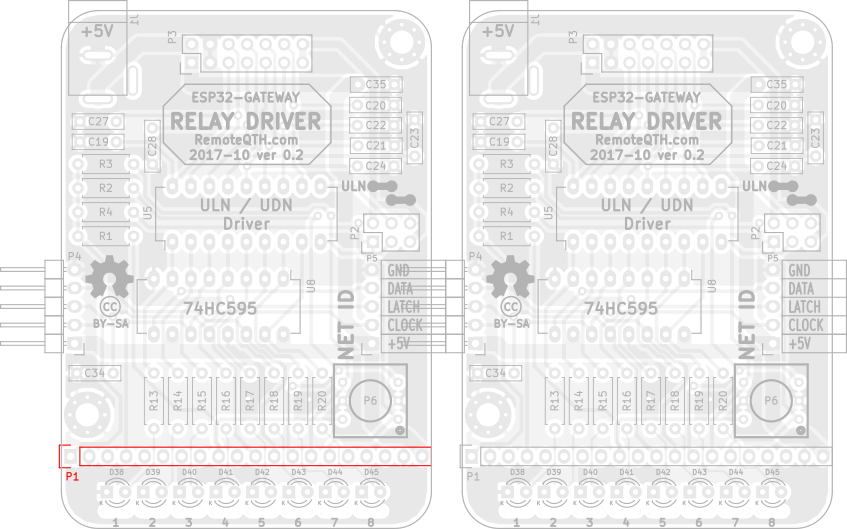
❏ One male 1x20 pin header P1 on LEFT board
Output driver
❏ Put output driver to DIP socket by your preferency

- ULN chip for switching by output collector (grounding) need use two Jumpers on left P2 pin strip

- UDN chip for switching by output emitter (voltage from P3 Vin) need use two Jumpers on right P2 pin strip

ESP32-GATEWAY board

❏ One femmale 1x20 pin header CON1 on TOP side OLIMEX ESP32-GATEWAY
LED1 on ESP32-GATEWAY show
- three times flashes - receive IP from DHCP server - Ethernet
- two times flashes - receive IP from DHCP server - Wifi
- one time flashes - receive broadcast pair packet
How to mout to DIN rail
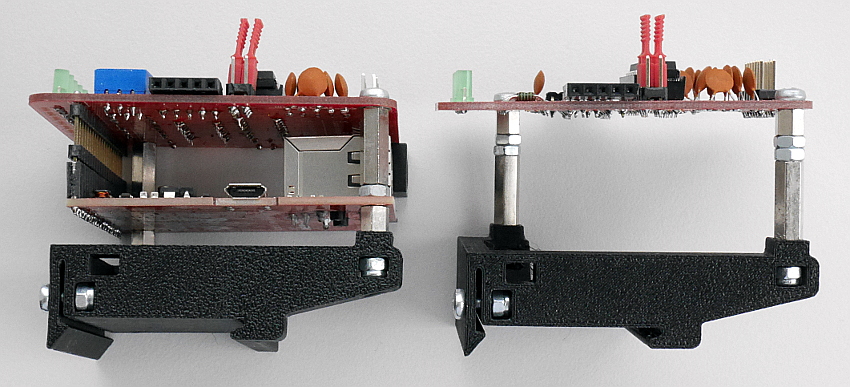
Firmware
- Download and install last version Arduino IDE
- Download and install ESP32 support for arduino from GitHub - prefered via board manager.
- Download IP switch firmware source from GitHub
- Edit source
- For use Ethernet (prefered connection) wiring connection preset configuration
#define ETHERNET // Enable ESP32 ethernet (DHCP IPv4) //#define WIFI // Enable ESP32 WIFI (DHCP IPv4)
- For use WiFi connection use this settings
//#define ETHERNET // Enable ESP32 ethernet (DHCP IPv4) #define WIFI // Enable ESP32 WIFI (DHCP IPv4)
and set your SSID and password for accessconst char* ssid = "YOUR-SSID"; const char* password = "YOUR-PASSWORD";
- Select menu Tools/Board:"OLIMEX ESP32-GATEWAY"
- Connect micro USB between ESP32-GATEWAY and PC
- Select menu Tools/Port/YOUR-CONNECTED-PORT
- Upload firmware
Setup
Setup are available via CLI (command line interface).
How to access
- connect micro USB cable
- run terminal - for example Ctrl+Shift+M in Arduino IDE
- set baudrate to 115200 and No line ending.
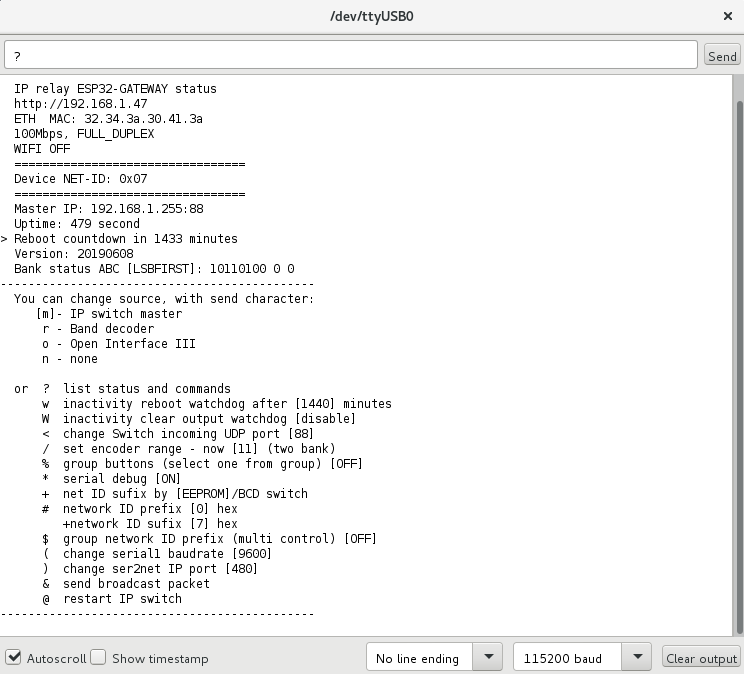
CLI contains some commands for set or show information.
Commands for set source device
- m - Manual IP switch
- r - Band decoder MK2
- o - Open Interface III
Other commands, RED is important
- ? - show status and help
- / - set encoder range (2-g) for switching one from range
- * - enable/disable serial debugging
- + - select get Network ID sufix from eeprom or hardware BCD switch
- # - set network ID
- Prefix (four high bit) in hexadecimal format (0-f)
- in standart mode prefix expanded range of network ID
- if enable Multi control, prefix disable, and use only on master device for his idetifications
- Sufix (four low bit) in hexadecimal format (0-f)
- settings available if sufix get from eeprom
- in standart mode sufix use for identification
- in Multi control mode define group ID (id for all shared devices)
- $ - enable/disable Multi control function (sharing up to 16 master device)
- . - if enable Multi control, show list detected IP switch by ID prefix
- @ - restart IP switch
For controlled from Manual IP switch
- Upload firmware by previous steps
- Set encoder range via CLI with command n
- Set source via CLI or web interface to m
- Set network ID prefix same on both devices via CLI in range 0-7
- Select Network ID sufix same on both devices with BCD switch in range ID 0-7
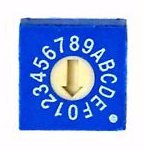
- Connect to same local network with DHCP as Manual IP switch
- After power up both devices, is automaticaly pair
Web status page
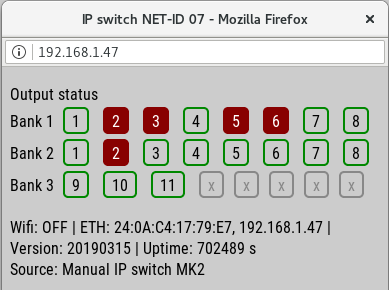
- Show all outputs status
- Parameter of WiFi or ethrnet IP connect
- Firmware version
- Device uptime
- How source controled his
- Notice - show this page can extend reaction latency IP switch
How IP addres got the device from the DHCP server?
- show in serial terminal after reboot, or send ? character
- or find some network scanner
Secure remote manage
Configuration available via serial CLI (command line interface). This interface can be safely accessed to the Internet and encrypted connections to manage all features
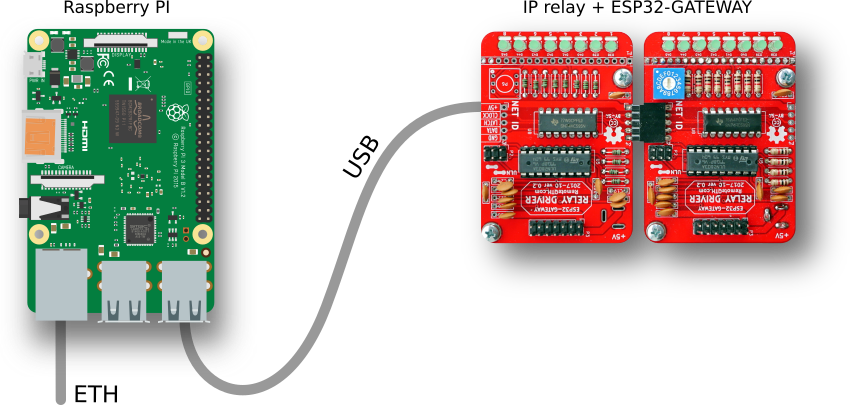
What you need
- any version Raspberry PI
- microSD card with Raspbian Lite
- micro USB cable
- 5V power adapter with micro usb cable
- ethernet connection
- for first start HDMI monitor and USB keyboard
How to start
- after first boot login to serial console with default login pi and password raspberry
- run command and enable SSH
sudo raspi-config
- run command and write down the shown IP address
ip a
- you can disconnect HDMI monitor and USB keyboard
- connect to Raspberry PI from any other PC
- update system with run command
sudo apt-get update && sudo apt-get upgrade
- install screen fith command
sudo apt-get install screen
- run screen
screen /dev/ttyUSB0 115200
- now after pres any key show status information and you can configure via CLI
